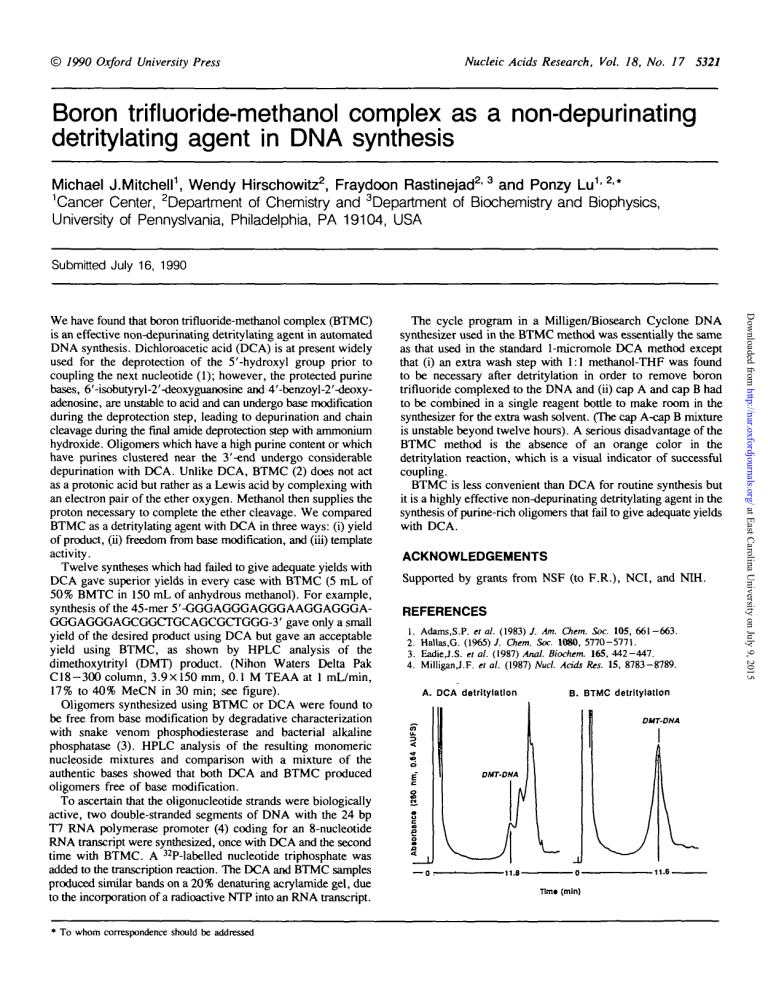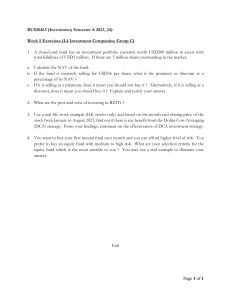BTMC in DNA Synthesis: A Non-Depurinating Detritylating Agent
advertisement

© 7990 Oxford University Press Nucleic Acids Research, Vol. 18, No. 17 5321 Boron trifluoride-methanol complex as a non-depurinating detritylating agent in DNA synthesis Michael J.Mitchell1, Wendy Hirschowitz2, Fraydoon Rastinejad2'3 and Ponzy Lu1>2>* 1 Cancer Center, department of Chemistry and department of Biochemistry and Biophysics, University of Pennyslvania, Philadelphia, PA 19104, USA Submitted July 16, 1990 • To whom correspondence should be addressed The cycle program in a Milligen/Biosearch Cyclone DNA synthesizer used in the BTMC method was essentially the same as that used in the standard 1-micromole DCA method except that (i) an extra wash step with 1:1 methanol-THF was found to be necessary after detritylation in order to remove boron trifluoride complexed to the DNA and (ii) cap A and cap B had to be combined in a single reagent bottle to make room in the synthesizer for the extra wash solvent. (The cap A-cap B mixture is unstable beyond twelve hours). A serious disadvantage of the BTMC method is the absence of an orange color in the detritylation reaction, which is a visual indicator of successful coupling. BTMC is less convenient than DCA for routine synthesis but it is a highly effective non-depurinating detritylating agent in the synthesis of purine-rich oligomers that fail to give adequate yields with DCA. ACKNOWLEDGEMENTS Supported by grants from NSF (to F.R.), NCI, and N1H. REFERENCES 1. 2. 3. 4. Adams.S.P. el al. (1983) J. Am. Chem. Soc. 105, 661-663. Hallas.G. (1965)/. Chem. Soc. 1080, 5770-5771. Eadie,J.S. et al. (1987) Anal. Biochem. 165, 442-447. MilliganJ.F. el al. (1987) Nucl. Acids Res. 15, 8783-8789. A. DCA detritylation B. BTMC detritylation DHT-DNA o E" DMT-DNA s 3 — 0 r- -11.6- -11.8Ttm« (mln) Downloaded from http://nar.oxfordjournals.org/ at East Carolina University on July 9, 2015 We have found that boron trifluoride-methanol complex (BTMC) is an effective non-depurinating detritylating agent in automated DNA synthesis. Dichloroacetic acid (DCA) is at present widely used for the deprotection of the 5'-hydroxyl group prior to coupling the next nucleotide (1); however, the protected purine bases, 6'-isobutyryl-2'-deoxyguanosine and 4'-benzoyl-2'-deoxyadenosine, are unstable to acid and can undergo base modification during the deprotection step, leading to depurination and chain cleavage during the final amide deprotection step with ammonium hydroxide. Oligomers which have a high purine content or which have purines clustered near the 3'-end undergo considerable depurination with DCA. Unlike DCA, BTMC (2) does not act as a protonic acid but rather as a Lewis acid by complexing with an electron pair of the ether oxygen. Methanol then supplies the proton necessary to complete the ether cleavage. We compared BTMC as a detritylating agent with DCA in three ways: (i) yield of product, (ii) freedom from base modification, and (iii) template activity. Twelve syntheses which had failed to give adequate yields with DCA gave superior yields in every case with BTMC (5 mL of 50% BMTC in 150 mL of anhydrous methanol). For example, synthesis of the 45-mer 5'-GGGAGGGAGGGAAGGAGGGAGGGAGGGAGCGGCTGCAGCGCTGGG-3' gave only a small yield of the desired product using DCA but gave an acceptable yield using BTMC, as shown by HPLC analysis of the dimethoxytrityl (DMT) product. (Ninon Waters Delta Pak C18-300 column, 3.9x150 mm, 0.1 M TEAA at 1 mL/min, 17% to 40% MeCN in 30 min; see figure). Oligomers synthesized using BTMC or DCA were found to be free from base modification by degradative characterization with snake venom phosphodiesterase and bacterial alkaline phosphatase (3). HPLC analysis of the resulting monomeric nucleoside mixtures and comparison with a mixture of the authentic bases showed that both DCA and BTMC produced oligomers free of base modification. To ascertain that the oligonucleotide strands were biologically active, two double-stranded segments of DNA with the 24 bp T7 RNA polymerase promoter (4) coding for an 8-nucleotide RNA transcript were synthesized, once with DCA and the second time with BTMC. A 32P-labelled nucleotide triphosphate was added to the transcription reaction. The DCA and BTMC samples produced similar bands on a 20% denaturing acrylamide gel, due to the incorporation of a radioactive NTP into an RNA transcript.


